




Our premium calcium silicate brick delivers lifetime performance, as only masonry exteriors can. For modern designs, our Contemporary Brick features long lengths in popular light tones, with a distinctive textured finish. Arriscraft products have been proudly made in Canada since 1949.





Canada is not for the weak. Brutal winters and rugged terrain. It’s not easy work, but that’s exactly why we love it. Convoy’s been at the heart of the Canadian construction industry since 1972. And just like moose...we mean business.

It's Complicated
Buying Canadian is a noble

P24
The DC Repair Kit
How to bring development charges back down to earth

Homegrown Tech
Made-in-Ontario building software that's ripe for the picking
9 Association News
The facts and fiction of tariffs, a new report cites the impact of unaffordability, recapping the Ontario election, and why are you an OHBA member?
17 Inside Storey
Money laundering has infiltrated the home-building industry. Here's how to protect your company.
21 Trending
From an all-in-one heating and cooling solution to online courses to power up your career, here's what’s new in industry products and services.
49 Building Buzz
An intriguing initiative from Kingston HBA, big funding for the Carpenters' Regional Council, and more news.
55 Product Focus
A roll call of top toilets, from Canadian buildergrade products to environmentally friendly bidet-seat models for your discerning clients.
62 Chapter Spotlight
Greater Ottawa HBA Executive Director Jason Burggraaf has some capital ideas for member recruiting.

ON THE COVER
Locally sourced products can help avoid the weight and unpredictability of tariffs, but it's far from an easy solution.




1


EZNavTM multi-line control with built-in intuitive software
2
Easy whole home recirculation with optional NaviCircTM recirc valve
3
High efficiency up to 0.96 UEF allows for BIG savings when designing via performance path

4
5 6
7
Exclusive ComfortFlow® NPE-A2 internal buffer tank and recirc pump
CSA P.9-11 rated with multiple air handler options
Dual stainless steel heat exchangers and 2” PVC venting up to 75
NPE-2 tankless is great for most programs, such as Energy Star, Net Zero Ready and more!
Endless hot water comfort is just one of many reasons to go tankless with Navien

On February 27, Ontario Premier Doug Ford was re-elected to his party’s third straight majority government. This is a historic accomplishment for Premier Ford. The last Ontario Premier to win three consecutive majority governments was Leslie Frost in 1955.
The Ford-led Progressive Conservatives (PCs) secured 80 seats, up from 79 before dissolution. The New Democrat Party, led by Marit Stiles, claimed 27 seats, a loss of one, and the Bonnie Crombie-led Liberal Party won 14 seats, up from nine before the election. The Liberal Party regained official party status in the Legislature by winning more than 12 seats, which gives them seats on committees, questions during question periods, and funding for staff and research. However, the Liberal Party leader failed to win a seat, which leaves her future as party leader uncertain. The Green Party, led by Mike Schreiner, held the two seats they had before the election. BobbiAnn Brady, the independent Member of Provincial Parliament (MPP) for Haldimand-Norfolk, won a resounding victory, making her the only person in Ontario’s history to be elected and re-elected as an independent.
The PCs campaigned on a platform of protecting the province’s economy from U.S. tariffs and standing up to U.S. President Donald Trump. In an unprecedented move, the Premier
twice went to Washington, D.C., to advocate for Ontario during the campaign. It was clear that voters were almost exclusively focused on Canada’s relationship with the U.S., as the opposition parties found it hard to change the channel to issues favourable to them. As a result, the PCs were able to win a majority government without much contest.
On March 19, 2025, Premier Ford announced the members of his cabinet. Prior to the swearing-in, the Premier called this a cabinet to protect Ontario while building a stronger, more competitive and resilient economy. The cabinet remained largely the same as before the election, with some position changes.
Notably, Minister Rob Flack (MPP for Elgin-Middlesex-London) became the Minister of Municipal Affairs and Housing, while Minister Paul Calandra (MPP for Markham-Stouffville) moved to the Ministry of Education. Minister Flack formerly held the positions of Minister of Agriculture, Food and Agribusiness, and Associate Minister of Housing. Before entering politics in 2022, Minister Flack was president and CEO of Masterfeeds, a leading Canadian animal nutrition business.
Graydon Smith (MPP for Parry Sound-Muskoka) became the Associate Minister of Municipal Affairs and Housing. Prior to his election to the Legislative Assembly of Ontario in 2022, he was chair of the Association of
Municipalities of Ontario and mayor of Bracebridge. Before the 2025 election, he served as Minister of Natural Resources.
Other changes to the Executive Council relevant to the residential construction industry include Minister Stephen Lecce (MPP for King-Vaughan), who continues as Minister of Energy while also picking up responsibility for Mines; Minister Todd McCarthy (MPP for Durham), who became Minister of Environment, Conservation and Parks; Minister David Piccini (MPP for Peterborough), who continues as Minister of Labour, Immigration, Training and Skills Development; Minister Stephen Crawford (MPP for Oakville), who became Minister of Public and Business Service Delivery and Procurement, where he is responsible for promoting a fair, safe and informed marketplace for consumers and businesses; and Minister Graham McGregor (MPP for Brampton North), who will oversee heritage and archeological issues as Minister of Citizenship and Culture.
This is a strong lineup of ministers who already understand our sector and the urgent need to build housing.
On the housing policy front, the PC platform included promises to work with municipalities to build housingsupportive infrastructure, change how development charges (DCs) are calculated to be consistent across the province, and ensure that revenue municipalities receive from DCs is used promptly and transparently.
We are encouraged by these promises and look forward to working with the new government to build on these commitments so that Ontario’s home builders can do what they do best— build more homes.
OHBA will continue to advocate for positive changes that will help our members. Our advocacy goals will continue to focus on reducing government fees and taxes on new homes, labour and workforce development, and reducing red tape in the approvals process by eliminating unnecessary studies and making the approvals process consistent across the province.
The need to build housing remains a top priority for many Ontarians, and OHBA will take every opportunity to push for fundamental policy changes that will benefit our members. OHB
FOR ONE HOME OR FOR MANY, THINK GOEMANS FOR YOUR NEXT APPLIANCE PROJECT.








Whether big or small, choosing Goemans for your project is sure to put time back in your day. Our responsive team will be there every step of the way from qualifying your needs, to dealing with your clients, to facilitating a smooth onsite delivery and quickly correcting issues. Do appliances right with Goemans and scan the code to connect with an experienced Commercial Account Manager.



“It provided a
learning opportunity for town sta and the project consulting team.”
Katelyn McFadyen Manager

Energy and Environment
Town of Caledon





Success story | Southfields Community Centre
Savings by Design helped the Town of Caledon explore sustainable design strategies, best practices and more during a no-cost integrated design process workshop. As a result, they built a high-performance, sustainable community centre.



$22,656/year
Projected annual energy cost savings
63,000 kg CO2e
Projected annual reduction of greenhouse gases
$27 million Total project cost
To get the most out of your next project, contact Venoth Jeganmohan, Energy Solutions Advisor.
enbridgegas.com/sbd-commercial
647-502-6759
venoth.jeganmohan@enbridge.com
“Advocacy for effective industry regulations, education and mentorship are vital pillars of what organizations like this stand for. By working together, we are advancing the industry and contributing to a stronger, more connected community of professionals. The opportunity to help shape the future of home construction while also giving back is one I truly value.”
— Do ug Taylor, President, Frontiers Design Build Inc.
“My ‘why’ is because I am grateful for the mentorship I’ve received along my career journey. My mentors have inspired my desire to engage, elevate and educate clients, colleagues and members of the communities I work in about the vast opportunities in the home-building industry.”
— Ka telyn Gillis, Senior Planner, Landwise
“I was blown away at the opportunities that were in front of me, thanks to the OHBA. They have continued to support me, my board, my community and my fellow industry members. Together, we are growing awareness, membership and the power of our voice.”
— Scott Darling, Regional Sales Manager, Terra Nova Truss
“Why stay involved with OHBA? It’s simple, actually—because I can’t not stay involved in OHBA. I simply can’t not stay involved!”
— Mi ke Memme, Operations Manager, Mountainview Building Group; Chair, OHBA
“When I joined the association, I think I was 20 and the youngest guy there. So I aspired to be like them. I wanted to be around them to listen to what they had to say and to gather the knowledge they had. From there, I was able to have my own voice. And now, I have the experience to advocate and am one of those people at the table who can speak on behalf of the association. It’s exciting to be involved— we’re building communities.”
— Sa m Bunting, Owner & Director of Construction, Prominent Homes
Everyone’s “why” is a little bit different—but all of them point to the power of connection, support and shared purpose within our community. These personal stories help bring our mission to life in a real, relatable way.

“My mentors have
inspired
“I
was blown away at the opportunities that were in front of me thanks to the OHBA. They
have continued to support me, my board, my community and my fellow industry members.”
Scott Darling, Regional Sales Manager, Terra Nova Truss
my desire to engage, elevate and educate clients, colleagues and members of the communities I work in.”
Katelyn Gillis, Senior Planner, Landwise


“I’ve gained much business, but, more importantly, friendships and relationships.”
Tim Oomen , Owner, Flooring Canada Simcoe and Tillsonburg
“Being a part of the OHBA has been so fruitful for my company. We’ve learned from all our peers, and we get to be involved in networking events. All of this brings more expertise to our own business. And the education component is incredible. You can’t learn this stuff just by being on your own.”
— Dwayne Butler, Owner, Master Edge Homes
“I’ve been a member for more than 12 years. I’m also actively involved in the board and as a supplier to builders. It’s been a great thing for me. I’ve gained much business, but, more importantly, friendships and relationships. If you’re on the fence about joining a local chapter, do it!”
— Tim Oomen, Owner, Flooring Canada Simcoe and Tillsonburg
“What drives me and fuels my passion for this association are the great people I see and interact with on a day-today basis, both in this region and across the province.”
— David Ionico, Partner, McHugh Whitmore LLP; Chair, West End HBA
“What drives our passion for working with this association is knowing that the work we do contributes to building vibrant, inclusive and sustainable neighbourhoods. Together, we’re creating homes and communities that will benefit generations to come.”
— Ma rk McGinty, CEO/Master Electrician, McGinty Toman Electric



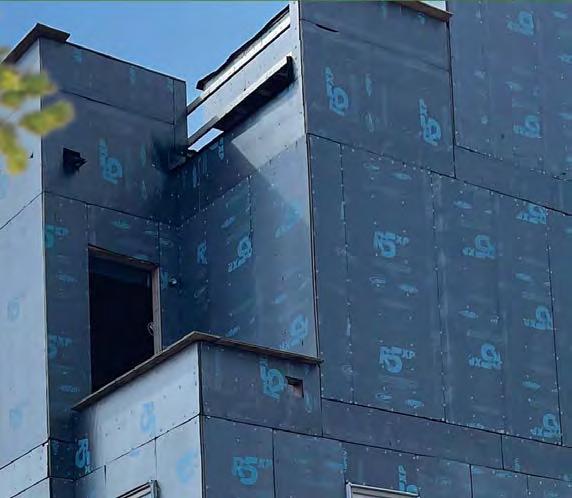
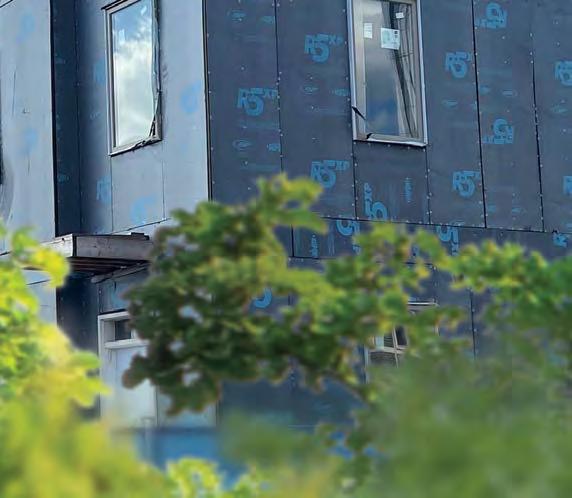



High performance
Bio-based building materials
Recycled wood fibre sourced from post industrial and post consumer origin

BP’s R-1.5 exterior sheathing panel provides structural strength, noise reduction, superior water vapour permeance at 37 perms, and a remarkably low carbon footprint, at a value based pricing. R-1.5 Continuous superior water vapour permeance – a perfect combination for our canadian climate.


BP’s Excel exterior sheathing panel provides R-1.5 of continuous insulation while providing superior structural strength, weather resistive and air barrier properties ensuring that your walls remain warm and dry, mitigating moisture entrapment in the wall cavity.



BP’s R-5 XP exterior sheathing panel provides R-5 of continuous insulation using Dupont’s low GHG STYROFOAM™ Extruded Polystyrene, laminated to a ½" high performance wood fiber panel. The overall panel assembly provides a water vapour permeance rating of 2 perms, ensuring an optimal performance of your overall building envelope.


information and that the value of the home corresponds to your customer. You also have to be aware of sanction risks. If you are going to be dealing with any individual or entity, you are expected to scan their names across the Consolidated Canadian Autonomous Sanctions List and Terror Watch List. You are also expected to conduct a negative news search to ensure that that individual is not connected to any criminal activity or enterprise. If there’s anything that doesn’t make sense, you should be flagging those. Then there’s the risk assessment end.
If I’m a home builder and I have an AML program, and you want to do business with me, I’m obligated to assess the transactions to see if they make sense or if they’re reportable. I’m also obligated to perform a risk assessment on that relationship. That means I would assess them as a client and determine whether the risk they pose is low, medium or high. If they’re Canadian, reside locally and are in a well-paying occupation like a doctor, that’s low risk. If they tell us they just moved to Canada from a high-risk country, they’re maybe medium risk. High risk is somebody from a high-risk country or occupation, like owning a Bitcoin ATM or being involved in a cash-intensive business like a car wash.
“It’s really important as a home builder that you have an AML in place to demonstrate to the regulator that before you made a decision, you riskrated the client, did considerable due diligence, and reviewed the transaction to see if there were any red flags before it was approved.”
“We have to consider human nature and how some react to regulatory compliance: If they feel they can get away with stuff, are they more likely to comply or look the other way? But the penalties can be severe. In more strict AML regimes like the U.S., we’ve seen financial institutions fined $9 billion for circumventing AML laws. In Canada, there’s been progress, but the enforcement of our AML laws is not as mature as in the U.S., so it’s quite challenging for the regulators to ensure that everybody toes the line.”



UP TO 22% BETTER ENERGY EFFICIENCY 26% LOWER PROFILE FRAME FOR EXPANDED VIEWS
DURABLE VINYL AND HYBRID RESISTS WEATHER AND DAMAGE
AVAILABLE IN PREMIUM FINISHIELD TM LAMINATE COLOURS
Welcome in the beauty and brightness of spring with JELD-WEN®’s JWC8500 series window. This innovative window offers exceptional energy efficiency, a low-profile design and remarkably robust frame. This intentional engineering gives you cool, comfortable, and quiet interior spaces, expansive views and long-lasting performance.
Experience the world in a whole new way this spring with JELD-WEN ®’s
JWC8500 series window .

7 Oaks, a professional arboricultural consulting firm, specializes in the management of trees, particularly during land development. With ISAcertified arborists, it offers expertise in tree preservation and addressing municipal bylaws and their requirements. Combining scientific knowledge with practical solutions for sustainable preservation, 7 Oaks helps ensure trees thrive during development projects, enhancing their longevity and safety while satisfying municipal specifications. 7OAKSTREECARE.CA
Markham’s Beaver Valley Stone has introduced a versatile new natural stone for custom home builders. Champlain Ledgerock is ideal for creating elegant retaining walls and curbing. Sourced from North America, it offers unmatched durability and a timeless aesthetic that enhances any landscape. Its unique texture and three colour variations (Corinthian Granite pictured) also add a touch of sophistication to outdoor spaces. BEAVERVALLEYSTONE.COM


JELD-WEN’s new JWC8500 Hybrid Series, the company’s most energy-efficient window, combines durability and style. Designed for Canadian climates, these customizable windows feature a streamlined, low-profile frame that maximizes viewing area, allowing more natural light to fill the room while providing longterm performance. For even greater durability, a hybrid aluminum-clad vinyl option offers enhanced strength and resistance to the elements. JELD-WEN.CA

Boost your credentials and career opportunities with training and certification from the Ontario Building Officials Association. With the 2024 Ontario Building Code now in effect, OBOA has updated its training courses to align with the new regulations, ensuring you stay current. Courses include Part 9 – Health & Safety, Part 9 – Building Envelope, Part 9 – Structural, and more. OBOA.ON.CA/TRAINING


Best-in-Class performance for both Dual and Triple glazed windows

Modern and slim design with improved functionality
Triple perimeter weatherstrip for best air/water leakage resistance


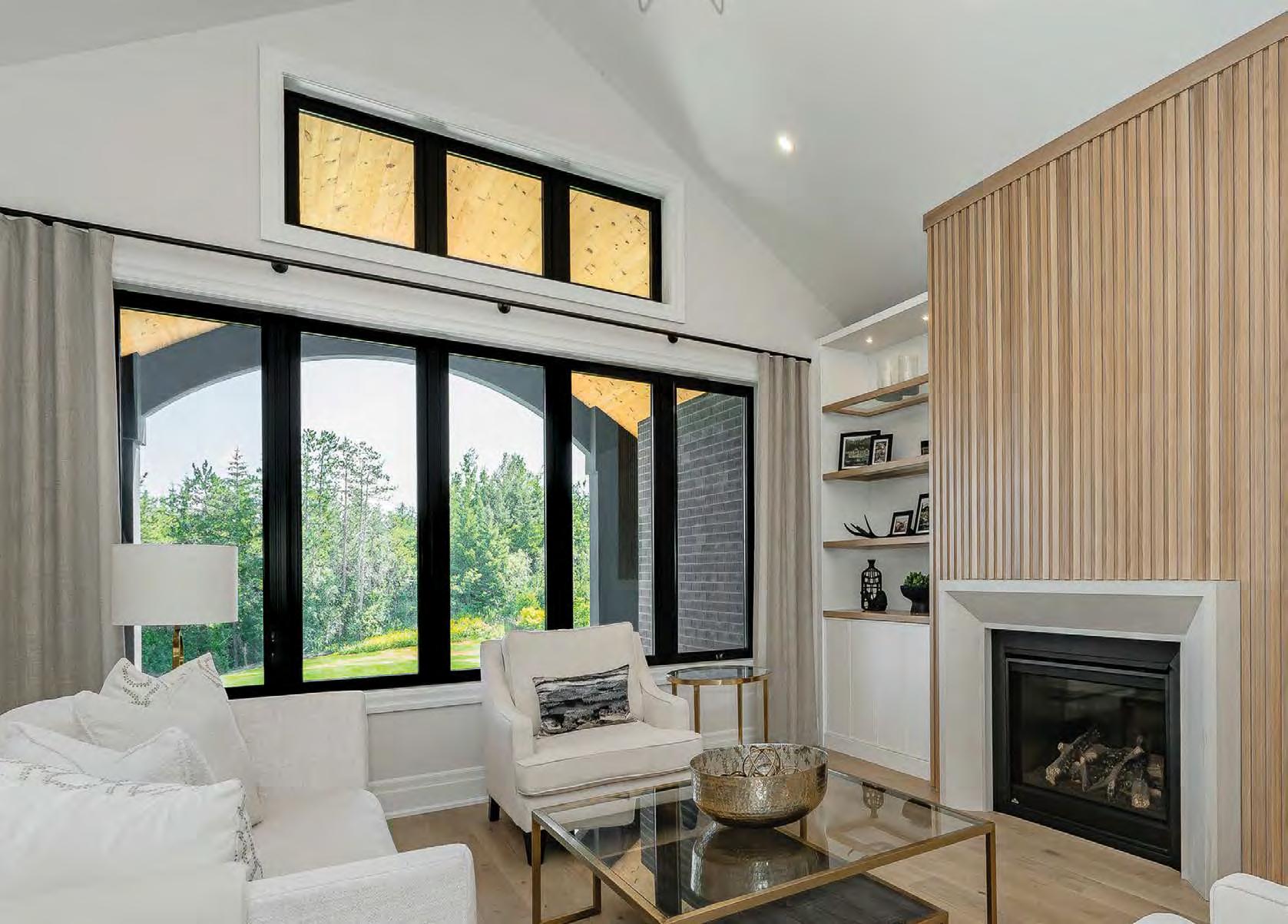





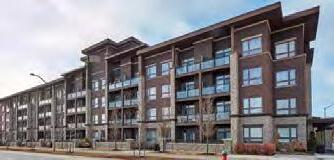
Some of the best builders choose Pollard Windows & Doors for their projects. A proud Canadian manufacturer of quality products, with more than 75 years in business. Pollard has earned the ENERGY STAR Most Efficient mark for Best-in-Class performance. With expert installation, exceptional service and an industry-leading 20-year warranty, you can trust Pollard to be the right choice for new home construction and multi-level buildings.
Aluminum reinforced mullions for larger window configurations For a free estimate today, call 1.800.263.6616 or visit pollardwindows.com

New study suggests how to bring development charges back down to earth
By Tracy Hanes
specializing in urban planning and land economics who previously worked with Keleher, says Keleher “did an excellent job with the report” and that it provides a path to technical fixes.
That list includes the following recommendations:
• El iminate upfront payments for sewer and water works through DCs. Use public or private-sector debt capacity to transfer these costs to an amortization payment made through a monthly surcharge on new homes.
• Remove land from ‘level of service’ calculations used to set DC rate caps to mitigate the undue influence higher land values have on DC rates. This would reorient DCs to adjust more closely to the pace of inflation for buildings and equipment rather than being susceptible to land value escalation.
• Limit the inclusion of capital costs to acquire land in DC capital programs to actual expenses only, rather than projections of the value of future lands that may need to be acquired, which are prone to overestimation. Using actuals rather than 10- to 25-year projections of land acquisition needs would better recognize the numerous other tools available to municipalities to acquire land and ‘shrink wrap’ the inclusion of costs recovered through DCs to only those that are incurred.
• Reduce subjectivity in DC calculations and implementation. Mandate the preparation of local service policies, features and necessary inclusions and ensure they are clear and easily interpreted.
• Allow pooling of capital costs for DC credits, such as merging ‘roads’ and ‘transit’ and certain soft services for purposes of calculating DC credit room.
• Require provincial oversight and approval of key elements of DC studies.
A key recommendation is that Ontario adopt a sewer and water cost recovery system similar to the State of Texas’s Municipal Utility District system (MUD) used by more than 1,300 special districts (a similar model is used in Quebec and Florida). The model could be used on a municipal-wide basis or for specifically defined sub-areas within a municipality.
The MUD model would take estimated capital water/sewer works costs out of upfront DCs and amortize those over the long term until the debt is paid off.
The report’s suggestions are not about reinventing the wheel; they’re about taking away upfront DCs and shifting how the costs are imposed, Keleher assures. “It has a lot of benefits for home builders, buyers and municipalities.”
Under the current system, water and sewer costs are estimated for 20 to 25 years in the future, explains Keleher. “The upfront DCs allow municipalities to build new infrastructure. The municipality often borrows to build these. DCs pay upfront for all that capital, although the money is borrowed and paid back long-term.”
Currently, that capital is included in DC charges, embedding it into new-home prices and increasing mortgage amounts for homebuyers. With the suggested model, municipalities would collect the costs through surcharges on homeowner utility bills, matching the payback period for the debt used to finance the capital works in the first place.

“Frankly, it’s how we pay for other utilities,” says Collins-Williams. “There are no natural gas or electrical development charges in Ontario. The infrastructure for maintaining and expanding those systems is built into the monthly rate and spread among users. It’s paid for over time rather than upfront.”
The report also recommends “right-sizing” how land values affect DCs. Under the existing system, the influence of land values is becoming disproportionate. This creates a negative cycle in which higher land values, driven by a shortage of housing supply, put upward pressure on DC rates, further hindering supply.
Keleher says there is “cap room” that DCs must stay within, but as land values escalate, so does the available cap room. That, in turn, allows municipalities to hike DC rates—especially in the GTA— whether or not the functional service level (square feet per capita) is increasing. Making more explicit policies would help ensure that new home buyers are not paying (through DCs) for things existing homeowners benefit from. In Hamilton, DCs have been used to finance things such as a landfill site, airport expansion and municipal parking, notes Collins-Williams. In KitchenerWaterloo, a $144 million athletic facility

“Markets have their own way of naturally recovering; if the market goes down, costs go down, and someone can come in and rebuild.”

“We need the federal and provincial government to step up. It’s profoundly unfair that infrastructure built to last for generations is being downloaded to mortgages for first-time buyers and newcomers.”
Mike Collins-Williams CEO, West End HBA

with an Olympic-sized swimming pool was primarily funded by $126.2 million in DCs, with no local taxpayer money used, as reported by The Globe & Mail
Beheshti prepared the Canadian Home Builders’ Association (CHBA) 2024 Municipal Benchmarking Study, which was released in March 2025. The study examines how development processes, approvals and charges impact housing affordability and supply in major markets nationwide. Beheshti says overall fees have increased, from DCs and parkland dedication to community amenity charges.
“The total fees municipalities tax on housing are based on a combination of various charges. Some fees, like community benefit charges, are taxed based on land values and so move in the general direction of the real estate sector. If there is less market activity, like we’re currently seeing with the decline in home building, then this portion of municipal fees likewise typically comes down in step with land appraisals,” says Beheshti. “However, the taxation room freed up from lower land taxes was more than made up for by increases in development charges, which are not marketbased, and so the total overall municipal tax burden on homes has gone up.
“This is a huge problem, and planning cannot operate at the speed of markets,” Beheshti adds. “Markets have their own way of naturally recovering; if the market goes down, costs go down, and someone can come in and rebuild.”
Beheshti says that because fees such as DCs are not decreasing, the market is dysfunctional, and developers are unable to provide competitive pricing because their costs are not dropping. Thus, release valves become bankruptcies, which leads to job losses in the housing industry and fire sales on land. Keleher says it’s time to have increased provincial oversight of DCs. Over the years, he has done peer reviews on DCs for home builders, development associations and industry groups in 84 different municipalities. He says there is a lack of oversight from the province, and the only scrutiny these DC bylaws receive is through third-party peer reviewers. While the province does provide oversight for Education Development Charges, which go through Ministry of Education approval, no such system exists for municipalities and DCs. “Given how high DC rates are, it’s time for the province to have some kind of oversight,” Keleher observes. “It’s an important planning policy and can affect whether there is or isn’t growth.”
Collins-Williams says the current system has “sliding systems that go all over the place” and agrees it would be beneficial to have stronger provincial oversight and more rules so there is consistency in how DCs are calculated. “Let’s dig in,” he notes, “so that it’s not ‘fun with numbers.’”
Collins-Williams says that as housing prices are a priority of the federal and provincial governments, and that

Daryl Keleher Principal, KPEC
“We have got to get creative and look at the entire system. DCs aren’t going to go away. Let’s focus on what growth rates are to be paid upfront and what nuances in the system potentially inflate the costs.”
growth-related infrastructure will be required, representatives of all levels of government must be involved in the major pieces of regional and city infrastructure if we are to enable growth and benefit existing communities.
“We need the federal and provincial governments to step up,” he says. “It’s profoundly unfair that infrastructure built to last for generations is being downloaded to mortgages for first-time buyers and newcomers.”
What is also aggravating, according to Collins-Williams, is that HST is applied on top of DCs, meaning an additional 13% (or $13,000 in the case of a $100,000 DC) is added on top. “You apply taxes to things like booze and cigarettes to discourage consumption. These taxes are discouraging homes from getting built!
“The entire DC system needs an overhaul,” Collins-Williams says. “There needs to be more consistency in how the rules are applied. DCs aren’t all black and white. There is a lot of grey area.”
Still, there have been some bright spots. Collins-Williams says Burlington was the first Ontario city to cut fees, albeit not significantly. Mississauga has also made major cuts. And the City of Brampton has launched Ontario’s most ambitious office development incentive program, waiving DCs for all office and mixed-use projects to attract investment and support job creation.
In November 2024, the City of Vaughan approved reductions to DCs, reverting rates for residential development applications to those used on September 21, 2018. These rates will be in effect for five years, until November 19, 2029. The DC rate for low-rise residential was $94,466 prior to the announcement and is now $50,193.
“Development charges have become an unfair tax burden on homebuyers,” says Vaughan Mayor Steven Del Duca. “Too many of our residents, particularly young families in our community, have seen their dream of buying a home near where they grew up disappear completely as housing prices have spiralled out of control. We have a housing affordability crisis, and it’s time for us to get real about the solutions needed to solve it.
“Vaughan was one of the first municipalities to reduce our development charges to help tackle the housing crisis,” Del Duca adds. “I called on other cities to follow Vaughan’s lead, and since then, other municipalities
have implemented similar reductions in their development charges.”
Perspective is important, though. While Vaughan has substantially lowered its DCs, Beheshti notes that the city and York Region’s combined high charges still result in high fees.
In March, Toronto Mayor Olivia Chow’s Executive Committee Deputy City Manager Jag Sharma and CFO Stephen Conforti proposed that select condo builders be allowed to defer development charges for up to four years without interest. The move is meant to lower the upfront money needed for projects, as many are stalled by high borrowing and building costs. However, eligible projects would need to include at least 5% affordable housing, whether lowercost rentals or owned homes. They must also submit a completed site plan for their proposed development before March 1, meaning only projects already in the works would qualify.
The CHBA study, meanwhile, benchmarked municipalities based on fees charged for new residential development, the length of time required for residential development applications to move through the process, and features that help applicants navigate the development application process.
Edmonton, Halifax, and London ranked highest overall, and those cities are “booming,” according to Beheshti. Of the 10 lowest ranked, seven are in Ontario. The four lowest ranked are Toronto, Bradford West Gwillimbury, Markham and Pickering, due to lengthy approval processes and high fees on development applications and residential developments. Municipalities that take a long time to approve projects plus have high fees, including DCs, have “poor outcomes” and affordability issues, says Beheshti.
Keleher believes DCs are the biggest needle mover in terms of housing supply. “We’ve got to get creative and look at the entire system,” he says. “DCs aren’t going away. Let’s focus on things like what needs to be paid upfront versus paid over time, and what nuances in the legislation may be inflating calculated rates beyond what the true costs are. Due to the speculative nature of future land values, there is an artificial increase in all DCs. It’s a tweak rather than a total system change, but we have to look at everything.” OHB


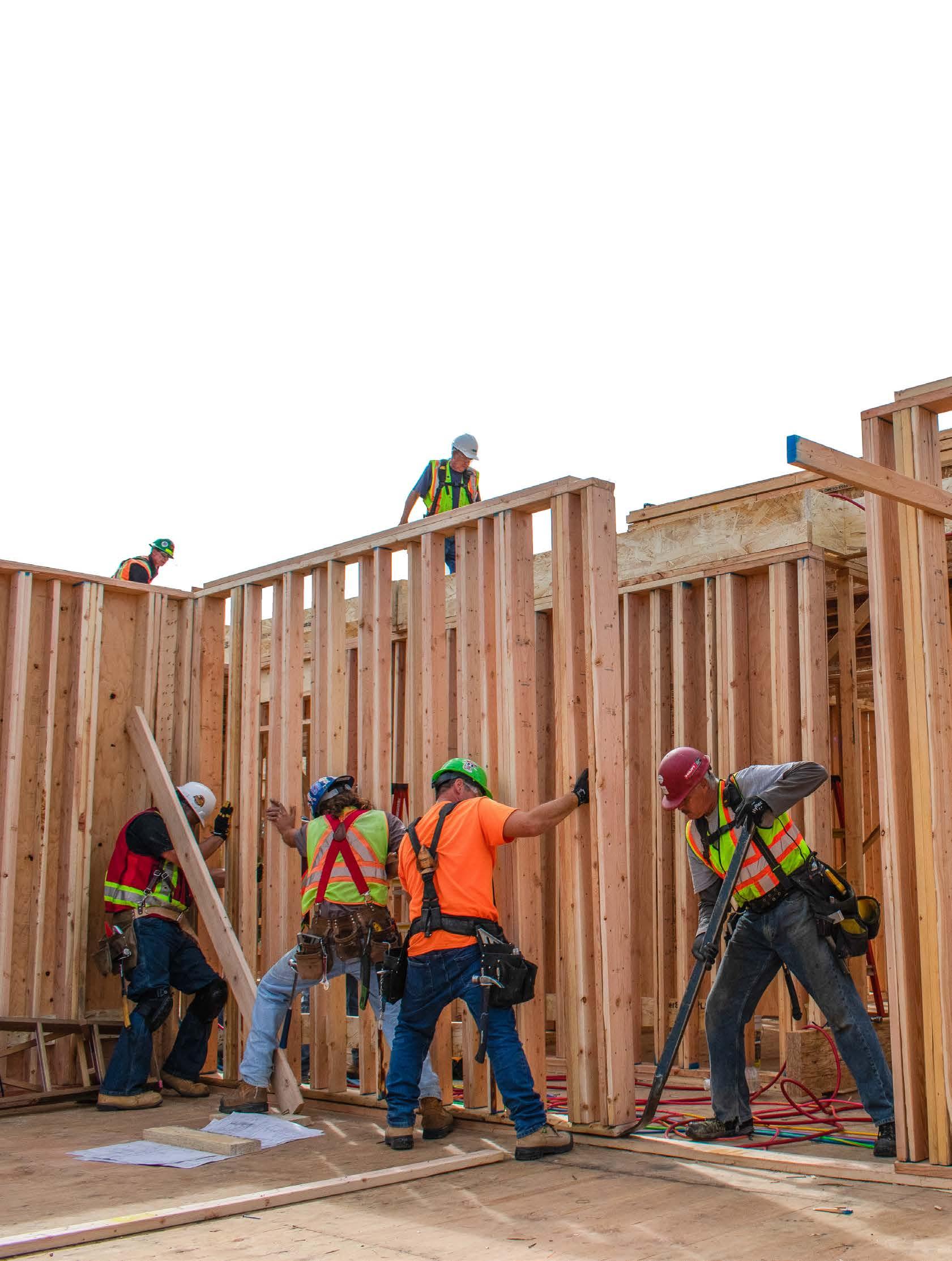


‘Buying
Canadian’ is a noble pursuit, but suppliers are caught in the middle
By Marc Huminilowycz
BACK IN 1969, when the late Pierre Elliott Trudeau, Prime Minister of Canada, travelled to Washington to meet with President Richard Nixon, he said something that came to define relations between Canada and the U.S.: “Living next to you is in some ways like sleeping with an elephant. No matter how friendly and even-tempered is the beast, one is affected by every twitch and grunt.”
Today, under the second Trump administration, the elephant is twitching and grunting like never before. The NAFTA honeymoon is over, as our neighbour to the south has been threatening and/or imposing stiff tariffs on Canadian-made goods, while our government is countering the threat with its own taxes on U.S. imports, and some provinces even banning U.S. products outright. While it is an admirable and
patriotic rallying cry, “Buy Canadian” presents a complex challenge for Canadian industry manufacturers and suppliers currently facing tariffs on the raw materials and components they need to manufacture and assemble their products, and on the sales of their products into the lucrative U.S. market.
The North American auto sector exemplifies the conundrum. Vehicles made here are assembled via a complex web of interconnected supply chains that use raw materials and parts suppliers from across the continent. An infographic created by the Automotive Parts Manufacturers’ Association illustrates the complexity of a typical rear suspension


Andrew Borsk V.P. of Marketing and Merchandising TG Appliance
describes the manufacturing of their products as a cross-border process.
“Phantom’s aluminum is smelted in Canada, extruded in the U.S., then assembled in Canada. The fibreglass used for some products also comes from the States,” he says. “Because Phantom Screens is facing tariffs from both sides of the border, I think it will ultimately affect product costs, but not yet. Right now, Phantom is trying not to be too reactive, absorbing some costs, particularly for American distributors, who represent about 80% of the company’s business. But there’s a lot of uncertainty about the future. Our biggest worry is that we will have to eventually increase our prices.”
Attfield believes Phantom will have to look more locally at some point, but he acknowledges the difficulty in doing so when it comes to quality control, existing contracts and volume needs. “Right now, Canadian supply is just not big enough to meet Phantom’s supply requirements,” he says. “It won’t happen that fast.”
Pollard Windows & Doors is a 77-year-old, fourth-generation, 100%

Canadian-owned company that manufactures its premium products in its 350,000-square-foot plant in Burlington. As is the case for many other Canadian door and window manufacturers, all of Pollard’s window glass comes from the U.S.—and that is a big problem according to Pollard President and CEO Karen Pollard-Josling.
“There is no window glass manufacturing in Canada,” PollardJosling explains. “Although we have Canadian suppliers for other raw materials, and can also get them from other countries like Europe, tariffs on the American glass that we use are imminent and problematic. Tariffs will have a significant impact on Canada’s window and door industry. Our association, Fenestration Canada, is currently lobbying the government on our behalf to reconsider countertariffs on glass, specifically glass with HS (Harmonized System) codes. We’re buying our glass in U.S. dollars, which compounds the problem, and we have suggested to one supplier that they should open a plant in Canada. Windows are becoming more and
At least 51% of the total direct costs of producing or manufacturing the goods have been incurred in
A minimum of 98% of the total direct costs of producing the item have been incurred in Canada.
A (by no means comprehensive) sampling of Canadian-owned and/or manufactured products
Appliance Canada
A wholesale supplier to the province’s rental housing and builder/developer markets.
Canadian Appliance Source (CAS)
Notes itself as “the fastest growing provider of major home appliances in Canada for over 15 years.”
Coast Appliances
Vancouver-based Coast has been Canadian-owned and operated since its founding in 1978.
Euro-Line Appliances
Oakville-based, they have been bringing in European-engineered appliances for over 25 years.
TA Appliances
Featuring a dedicated builder division, this family-owned business began in Kitchener in 1906.
TG Appliances
Brampton’s TG is a 2014 merger of Goemans Appliances (est. 1978) and Tasco Appliances (1954).
The Brick
Founded in 1971, it features 209 stores and seven distribution centres nationwide.
Alpa Lumber Group
Operating primarily in the GTA, its corporate umbrella covers such companies as Tamarack Lumber and Casa Bella Windows.
Building Products of Canada
Part of Saint-Gobain, a global leader in materials and solutions for construction markets, BP Canada manufactures roofing and wood fibre products, many of which are made in Canada.
Hewson Brothers
Family-owned, it’s one of the few remaining building suppliers not bought out by an American company.
Home Hardware Stores Ltd.
The largest independent home improvement retailer in Canada.
Jona Panel Sales
This Kelowna company offers environmentally friendly building materials.
Turkstra Lumber Company
This family-owned business has 11 retail locations and five specialty divisions across Southern Ontario.
Alleguard/Amvic
Under the umbrella of Tennessee-based Alleguard, Amvic products are manufactured in Canada.
Convoy Supply
Established in 1972 in B.C., and now owned by Soprema, it specializes in building envelope materials.
DMX Membranes
One of North America’s largest suppliers of foundation wrap and drainage boards.
Stubbe’s
This precast concrete, cement and ready-mix company entered the residential market in 2001 with its hollow-core flooring system.
TRS Components Ltd
and Terra Nova Truss
TRS was founded in 1974. Terra Nova Truss was founded in 1991. Both are owned by Toronto’s Argyle Capital Partners.
Trusscore
This Palmerston company’s products range from its Wall&CeilingBoard to a PVC dock system.
Almar Vinyl
Serving the fence, deck and railing industry since 1983.
Arriscraft / Canada Brick
Under the umbrella of Austria’s Wienerberger AG, Arriscraft stone products are manufactured in Cambridge. Burlington’s Canada Brick has been a premier clay brick manufacturer since 1954.
Brampton Brick
A privately owned Canadian company with five manufacturing facilities—all within Ontario.
DuRock
A family-owned manufacturer of quality products in exterior insulation finish systems and specialty coatings for floors and walls.
Gentek
A Burlington manufacturer/distributor of building products, including siding, windows and other exterior materials.
Mitten Building Products
A cross-country distributor of exterior building products, including Canadianmade vinyl siding.
Rinox
Quebec-based manufacturer specializing in high-end landscape and masonry products.
Westlake/Royal
Building Products
The Royal brand of vinyl siding and most of the company’s aluminum products are made in Canada.
Giant Factories
(A. O. Smith Enterprises)
Parent A.O. Smith is based in Milwaukee, but Montreal-founded Giant is the only water heater manufacturer in Canada.
Napoleon (Wolf Steel)
Its furnaces, hydronic air handlers, air conditioners and condo packs are manufactured in Canada.
Elastochem
Family-owned, it manufactures polyurethane and epoxy-based materials, including building enclosure solutions and spray foam insulation.
Isolofoam
A specialist in the construction of eco-responsible products made of expanded polystyrene (EPS).
Owens Corning
Manufacturing products in Canada, including fibreglass insulation, extruded polystyrene rigid insulation and composite materials.
Rockwool
Milton is home to the first North American production facility of Rockwool stone insulation.
BreezeWood Hardwood Flooring
A 100% Canadian-owned and operated family company in Tillsonburg, founded in 1959.
Frendel Kitchens
Canadian-made cabinetry with over 50 years of experience.
Envisivent
Producer of premium flush-mount air vents.
Raywal Cabinets
This Thornhill firm has been Canadianowned and operated for over 70 years.
Riverside Millwork Group
Trim and moulding expert committed to manufacturing a range of its products in Ontario.
Vintage Hardwood Flooring
An Etobicoke-based manufacturer with plants in Ontario and Quebec.
Garex
Quebec-based manufacturer of highend garage doors.
Golden Windows
Began as a small Kitchener millwork plant under the name Golden Triangle Windows in 1961.
JELD-WEN
A manufacturer and supplier of windows and doors to the Canadian market since 1990, with facilities in Ontario and across the country.
Mastergrain Windows and Doors
This Midland-based firm is a fully integrated manufacturer of premium fibreglass door systems.
Northern Window & Door
Manufacturing Ltd.
Family-owned and operated, this Thunder Bay company specializes in custom vinyl windows.
Phantom Screens/Ontario Screens Systems Inc.
Founded in 1994, OSSI is a leading provider of retractable screens for doors, windows and large openings.
Pollard Windows & Doors
100% Canadian-owned, Pollard conducts all manufacturing in Burlington.
Raven Windows
London, Ontario’s Raven sources highend European tilt-and-turn window and door solutions.
Steel-Craft Doors
A family-owned manufacturer of highend doors since 1963.
Strassburger Windows and Doors
Born and raised in Kitchener-Waterloo, this family business dates to 1949.
Cooper Equipment
A full-service construction equipment rental company servicing contractors.
DuPont Canada
A Mississauga-headquartered subsidiary of multinational DuPont, with manufacturing facilities and operations in Kingston and Thetford Mines, Quebec.
EHS Sales/R&D Development Group
Stratford-based manufacturer of window wells and outdoor sump systems.
+osb
A 50-year-old Oakville manufacturer and distributor of plumbing products.
Radon Home Defence
The company’s The Lid product is designed and manufactured locally.
Roma Fence
A 56-year-old one-stop shop carrying concrete products, installation tools and related fence products geared toward the installation process.
Stephenson’s Rental Services
Founded in Welland, it has supplied construction companies with tools and supplies for more than 70 Years.
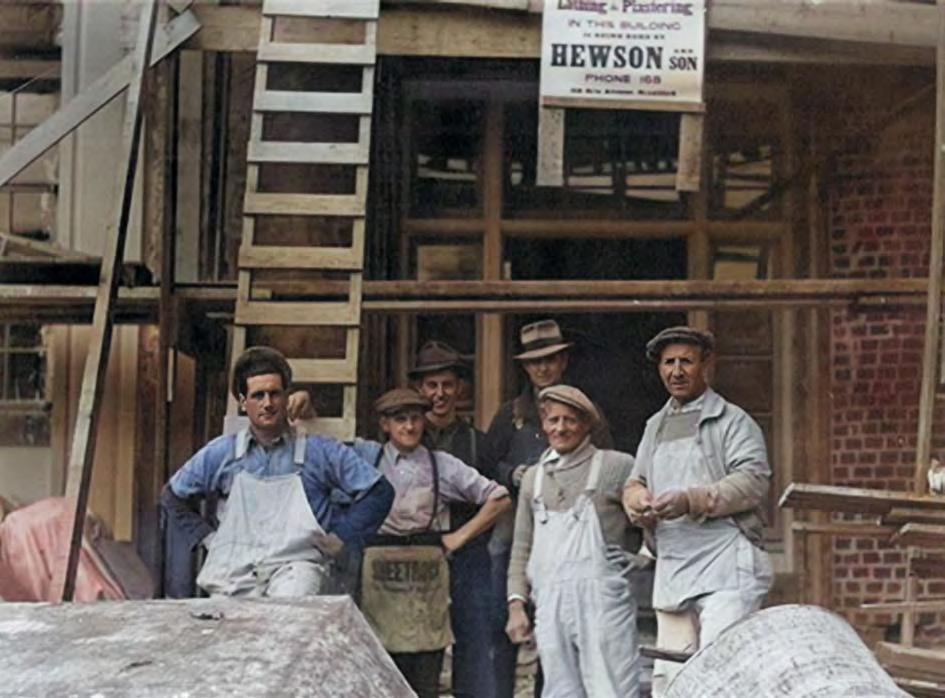




owned and operated company founded in 1975, is a leading manufacturer and distributor of plumbing products, including waste and water overflows, traps, lavatory drains, tubular brass fittings and other items. They manufacture and supply to
of some American products coming in. Canadian-made has been our target for many years, and we do manufacture a large percentage of our products in Canada. We do our own injection moulding, machine shop, fitting, manufacturing and assembly,
but some products we carry, like brass fittings, don’t contain enough content to claim they’re Canadian-made.
“Our original Island Tub Drain was groundbreaking, creating a new category and setting the industry benchmark for freestanding tub drains,” Ernst adds. “There is now a 25% tariff on the steel in this product, which our company has absorbed for now, but we may have to increase the price if tariffs go higher.”
One Canadian supplier sector that will undoubtedly feel the pain of tariffs is hardwood flooring. While a few Canadian companies manufacture flooring made of native hardwood species like maple, red oak and ash, premium species like white oak, hickory and walnut are preferred for premium homes. And those strains are only available from the U.S.
One wood flooring industry representative, who requested anonymity, remarked that his company’s building clients have long perceived his U.S. hardwood flooring as a premium North American product made in Canada. “If you look at a tree map of North America, you’ll see that 80% of softwood sits in Canada, while 80% of the hardwoods preferred for flooring grow in the U.S. I don’t know many Canadian floor manufacturers who don’t source their wood from around the world.”
The representative admitted that his company faces tariff concerns from both sides of the border. “People have their opinions on the issue, but because we have loyal clients in Canada and the U.S., we’re staying neutral and not taking sides,” he says. “Moving forward, we’re looking for some sort of stability before we make any long-term plans.”
The sooner this full-blown U.S.Canada trade war is over, the better. As of late April, negotiations were taking place between the two governments and associations representing industry groups. However, the unpredictable nature of the American president will make planning for the future rather difficult—and anxiety-filled.
Far beyond the mere twitches and grunts of the Pierre Trudeau-era elephant, this particular pachyderm has been on the rampage. And despite their best efforts, suppliers on both sides of the border are getting stomped in the process. OHB

• True Inverter experience that provides the ultimate in comfort for a homeowner.

• 40% smaller, and 53% lighter than traditional cube style units.
• Environmentally friendly - Now available in R-32, using less refrigerant.
• Ultra quiet and best in class humidity control.
• Available in Air Conditioner, Heat Pump, and Dual Fuel (Hybrid) applications!


Locally developed new building software tools appear ripe for the picking
By Ted McIntyre
When Pat Keaney made her way to the podium for her construction innovation seminar at Toronto’s Buildings Show in December, she had a packed house before her. In a world of tightening budgets, depleting support staff and lengthening delays, every industry could use a little technological help, and the construction folks in attendance were all ears.
The potential for improved efficiency is boundless, noted Keaney, who leads product management for the Autodesk Construction Solutions Intelligence division. The estimated cost of miscommunication and incorrect data in construction worldwide in 2020 was $88 billion, “and that number is probably conservative,” she said. “If I’m about to install something and an RFI came in two weeks ago and then a change in design, but the document didn’t get updated, it’s a tremendous waste in an industry that already produces a lot of waste. We’ve done surveys with our general contractors and third parties and consistently hear that they spend 35% of their time on unproductive activities. I’ve seen stats that people spend 20% of their time searching for project data. That data should be more accessible and smarter.”
Menatwork has long been ahead of the curve in terms of technological solutions that maximize the use of data and streamline procedures. A simple example for the design-build firm was the Grasshopper voicemail service it adopted almost 15 years ago and continues to use—translating voice to text before emailing a transcript to management.
Tech-savvy owners Paul Gallop and son Max employ multiple software products simultaneously in the company’s work. Max, managing director of the award-winning Toronto-based company, highlights Zapier as an essential piece of software in that regard. It’s a
backend automation utility that provides a foundation to build, manage and govern workflows, weaving various applications together to help automate tasks. “It’s very user-friendly,” Max says. “For example, we’re using a particular software to prepare estimates. It has a thousand rows of information. Zapier spins up a beautiful PDF of the estimate on another product like Docupilot. It then sends it to the client for a digital signature on another software, like SignNow. After the client signs, the system gets alerted and can automatically set up the customer in our accounting app, get an invoice queued, and notify the team. Automating repetitive administration like this keeps our team lean, and we aren’t restricted to any one system.”
Where much of current industry software still falls short, though, is client management. “The popular tools out there generally prioritize serving construction management interests—keeping your work, costs, timeline and scheduling organized,” Max notes. “Those are all important, but for the type of relationship we have with our clients we want something that truly elevates their experience.”
Menatwork has consequently developed its own solution. “We’re really excited about it and expect it will address a lot of the feedback from our clients and team,” Max says. “It’s currently proprietary, but could eventually help other businesses with this pain point in the future.”
Offering such tech can be a big selling point, Max believes. “A significant renovation project is intimidating. A lot of decisions need to be made and tracked. Then there are project finances, file management and innumerable discussions. Tools that make the client’s life less stressful will make our lives less stressful. Admittedly, I don’t think many homeowners are saying, ‘I’m only picking a renovator who has a portal.’ But it should
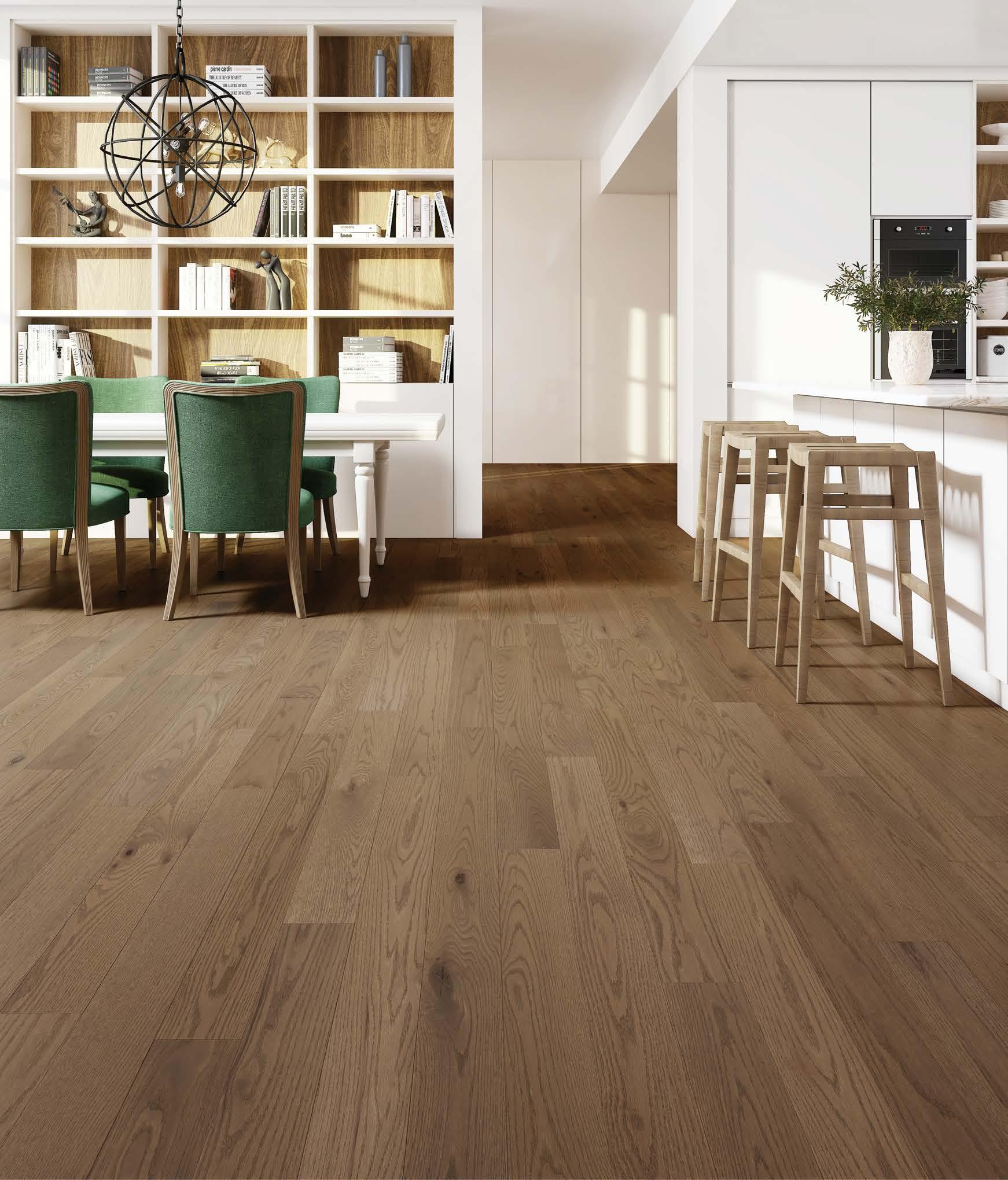

27%
of Canadian construction project managers are still relying on Excel or whiteboards to manage their projects.
laneway suite in your client’s backyard, it will inform you about things like how far you need to be from a fire hydrant.”
The software helps identify a piece of land’s potential, Shahi explains. “Many who own the land don’t have a clue what they can do on it. LandLogic has the data and can reveal what’s possible and what risks exist. We know if you’re in a floodplain or back onto a ravine. Beyond that, we can analyze every parcel in the jurisdictions we cover (42 municipalities and counting), whether it’s on the market or not. For example, we can identify which parts of Toronto qualify for a five-plex and highlight the best locations based on rental demand, estimated land value and zoning permissions. We can create a heat map of the best locations for a particular product.”
LandLogic is working on built-in pro formas so that builders can upload their own data and customize designs based on their numbers.
While Teranet remains Ontario’s official source for property ownership records, that’s just one piece of the puzzle. LandLogic goes to the next level by integrating zoning, infrastructure, market trends and development potential, giving users a clearer picture of a property’s true value. “Our AVM (automated valuation model) is the most accurate on the market,” Shahi assures.
“What’s exciting is how engaged the industry has been in shaping LandLogic,” he adds. “We’re not just building a product and telling people to use it—we listen to what developers, builders and realtors need, and then we build tools to solve those challenges.”
COST: $200/month, but an à la carte menu is also available. Companies can also finance tailored solutions to meet specific needs.
USER FEEDBACK: “Navigating approvals, zoning and site feasibility used to mean digging through scattered data, making endless calls and waiting weeks for
17%
of time on a typical project is spent searching for data or information.

Hlozan Director of Strategic Alliances, Trax Codes
of total time on a project is spent on re-work or rectifying issues. 27%














and contractors to improve efficiency and streamline their projects.
Tony Boyle Founder, CEO, Graditi
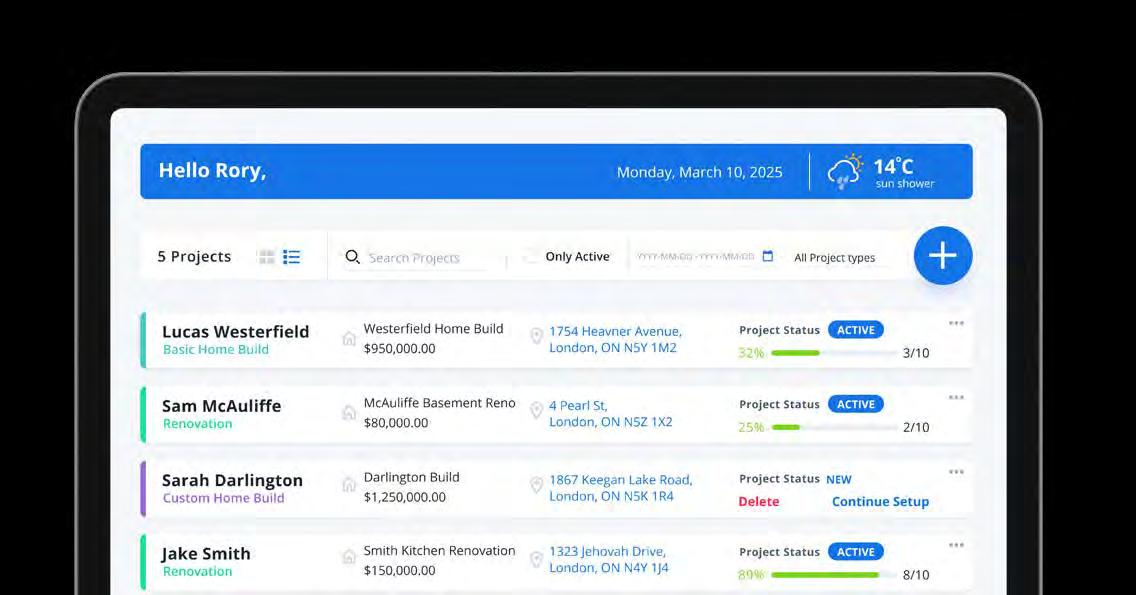
traditionally complex tasks, such as managing subtrade costs and credits, or quickly identifying discontinued items—practical functions that other similar software overlooks. Its floor plan annotation capabilities enable realtime collaborative feedback directly onto design documents, eliminating confusion and accelerating the approval process. And by streamlining financials with integrated online payment processing and digital signature capabilities, it creates an all-in-one solution. The software’s overall holistic approach—integrating a comprehensive messaging portal directly within the platform—allows designers and clients to communicate without ever leaving the software. That means designers spend less time juggling multiple systems and more time creating exceptional spaces for their clients using the product’s impressive visualization tools.
BACKGROUND: My DS Pro was launched earlier this year across North America by My Design Studio founder Yasmine Goodwin. “As the desire for our services increased, we needed a solution that could nimbly manage several projects at a time—we typically run about 20 sites per year and close to 1,000 homes,” explains Goodwin. “We found ERP (enterprise resource planning) software to be clunky, and it required the entire
database to be re-entered for every project—even within the same builder’s projects. We looked at partnering with other software companies but realized we’d have little control over what we needed, which included a visualizer, analytics and being able to have a central database that we could reuse. So we got our own software developers to create what we needed. After four years in the making, we launched My DS Pro. We currently have seven builders using our software, with over 800 homes completed.”
COST: Starting at $1,000/month.
USER FEEDBACK: “My DS Pro software is a very innovative tool that helps the builder, designer and homebuyer. The software is user-friendly, and visualizations make it easy to understand. What’s most impressive is the capability of providing up-to-date estimations as you navigate through your options. I’m looking forward to how the opportunities evolve.” —Aries Lobrin, Sunny Communities
WHAT IS IT? Launched in March, Graditi is an Ontario-built construction management software created by Canadian builders and software experts for small to medium-sized builders, remodelers
The platform streamlines every stage of construction projects. From planning and client communication to final inspection and invoicing, users can quickly gain full visibility and control over projects, including timelines and budgets. With a clear view of every detail, they ensure that no issues go unnoticed, and no costs are overlooked. Real-time updates keep clients, teams and trades aligned, reducing delays and misunderstandings.
“This is an intuitive experience that can be up and running in a day,” says founder and CEO Tony Boyle, a London, Ontariobased tech entrepreneur. “There’s no holistic (construction management) solution today that was built to help Canadian builders build faster than Graditi. All the current market offerings require weeks of training and a significantly higher investment. We made it as simple as ordering a pizza online. This was accomplished using a simple, modern interface that allows you to manage not just the build but your teams, tasks, invoices and the client journey from a single platform—all while seeing the financial impacts of changes along the way.”
BACKGROUND: Graditi was born from first-hand frustration with outdated construction management tools. After working on his dream home with Crown Homes’ owner Ken Bell, Boyle recognized the need for a more intuitive, all-in-one solution. Together with fellow Londoners Taras Zubyak, a seasoned software developer, and Neil Poutney, an experienced operations executive, they built Graditi.
Graditi is currently working with London HBA to explore the product’s potential.
COST: From $99/month (single user) to $389/month (up to 10 users and unlimited file storage). Free 30-day trial.
USER FEEDBACK: “Getting started with Graditi was surprisingly easy. We were initially concerned about the learning curve, but the platform was so intuitive, and our team picked it up quickly. Not only has it given us a quicker view of where each project stands and who is working on what, but it has also allowed us to elevate our personalized customer service in a whole new way.” — Trevor McKenzie, owner, McKenzie Homes. OHB

Initiative with local schools to grow trades is building on past success
In a recent conversation with older brother Tim, Scott Darling was espousing the virtues of a flourishing partnership between the Kingston Home Builders’ Association and local schools.
It’s a program that Scott, regional sales manager of Terra Nova Truss and Kingston Home Builders’ Association’s 2024 president, helped initiate.
“I was telling Tim about this
crazy-good educator we’re working with to promote skilled trades education in the area,” Darling shares. “That reminded Tim of this amazing woodshop teacher he had at school who did all these cool projects with students and who spent his summers building barns. Tim’s future career—he’s now the owner of Hawthorne Kitchens and Innotech Cabinetry in Kingston—was
inspired by this teacher. We didn’t realize for a few minutes that we were talking about the same guy—Geoff Petznick.”
Not that Darling needed any further validation, but it brought a smile to his face. When he helped create a new board position of education liaison at Kingston HBA three years ago, he indeed had picked the right person for the job. A passionate supporter of trades and apprenticeship opportunities for students, Petznick became a licensed carpenter at age 19, operating a successful barn-building and restoration business. A diploma in Heritage Carpentry and Millwork from Algonquin College was followed by a diploma in education at Queen’s University. He started teaching construction for the Limestone District School Board (LDSB) shortly thereafter and is now in his 25th year with the board.
Petznick’s addition augmented what was already a successful partnership. The LDSB has been a Kingston HBA board member for years. It is tied to Limestone’s Building Construction Internship Program, where teacher Dan Fisher oversees 15-20 students who construct one house per semester, working alongside a local contractor.
But Darling and the Kingston HBA wanted to up the ante. “We decided that instead of complaining about the lack of skilled young workers, let’s be part of the solution!” Darling explains. “We gave Geoff funding to be used at his discretion. He has his own committee as well. He gets to bring his perspective and influence our policy decisions, while we’re able to hear what’s going on and learn how we can help boost our local students toward the skilled trades.”
Kingston HBA and the program aren’t playing favourites. When they learned that the local Catholic school board wanted to develop a chainsaw program, they raised funds and purchased all the required equipment.
“I was a high school construction teacher at one point, and most people think, ‘What’s $1,000 really going to
accomplish?’” Darling relates. “But most teachers only have $500 per class for their semester budget. So whereas $3,500 for chainsaws isn’t that big a deal to us, to them it’s the reason all these kids can now be trained as arborists. We’re also sponsoring local skills competitions and home-building teams, as well as bulkbuying safety equipment like hard hats. But Geoff is the face of this. He’s one of the only people I’ve ever seen working at a high school board level who comes from the trades.”
Although a Specialist High Skills Major and Skilled Trades Consultant for the board, it’s Petznick’s pre-teaching qualifications that have always gotten youngsters to sit up and take notice. “I’m very proud of my carpentry licence—it got me to where I am today,” he says. “The kids don’t always appreciate the different destinations the trades can take them.”
But step one is instilling that same passion. Next is finding co-op placements for students. To that end, those enrolled in the house-building program are signed up for OYAP, which will provide funding for everything from training to work boots, allowing students to attend school while training as registered apprentices.
“I work with a great group of people who have a similar goal of introducing different pathways to university or college. My work is to promote the trades as just as viable a pathway as any other,” offers Petznick, who has witnessed the fruits of his labours. “We have former students of the program who are now business owners on our board of directors.”
Petznick also has a little blood in the game. “My wife, Caroline, is a carpenter too. Two of our four children are in the trades, and the younger twins are already talking about carpentry. Maybe we should start a company,” he laughs. Darling is just as enthusiastic about the future. “It’s a mission we’re so passionate about in Kingston,” Darling says. “We’re investing in our youth. And while we’re just getting started, we’re already seeing real, tangible results. We think of where this could be in 20 years, especially if other cities sign onto this as well. It’s not taking much money to make a big difference.”

The third edition of the bi-annual Canadian Home Builders’ Association National Municipal Benchmarking Study was not kind to this province.
Produced by Altus Group, the study examines market trends and several municipal land-use planning-related factors that may hinder housing supply and contribute to affordability issues in 23 municipalities across Canada. It benchmarks these municipalities on the following criteria: approval timelines, municipal fees and planning features.
This edition further details how a municipality’s performance on these measures influences housing outcomes, including affordability and availability for young families, and the total cost implications of these municipal processes and policies.
All 23 municipalities studied experienced explosive population growth between 2021 and 2023, although some of the larger areas (Toronto, Peel, and Vancouver) saw a significant outflow of residents through outmigration, as housing affordability deteriorated considerably in these regions.
Apart from the city of London, Ontario municipalities consistently benchmark below the rest of Canada. Repeating as the lowest four ranking municipalities were Bradford West Gwillimbury, Markham, Toronto and Pickering, due chiefly to lengthy approval processes and high fees charged on development applications and new residential developments. Edmonton, Halifax and London were the top-performing municipalities.
Since the 2022 study, municipal fees for new residential developments have increased by an average of $27,500 for low-rise units and $3,000 for high-rise units. Total municipal fees varied significantly, ranging from a low of $8,700 in Moncton to a high of $195,300 in Toronto for low-rise units, and from a low of $1,600 in Charlottetown to a high of $134,900 in Toronto for high-rise units.
A challenging economic backdrop and costly application processes are reportedly resulting in fewer submissions. Between 2022 and 2023, Ontario experienced a decline in applications from 466 to 324, a 30.5% drop. For site plan and development permits, usually the final stage in the planning process before a building permit is granted, Ontario witnessed a significant decrease from 792 applications in 2022 to 488 in 2023, marking a 38.4% reduction. In contrast, more affordable markets have experienced an increase in application submissions, with Alberta seeing a 17.7% jump in development permits between 2022 and 2023.
The contrast in submission trends between more and less administratively burdensome markets indicates that factors other than the economic backdrop and high interest rates impact future development intentions.
Approval timelines improved marginally from the previous study, taking an average application 11.2 months to complete in the 2022-2024 study period, down 2.1 months from the previous survey. The average timeline ranged from two months in Saskatoon to 31 months in Hamilton. Thirteen municipalities have better timelines than reported in the 2022 study, five have the same, and four are worse. The bottom five are all located in Ontario, with Hamilton showing the worst deterioration, with an increase of 8.1 months to 31 months total, dead last out of 23 cities studied.
Paperwork is a major culprit, with Hamilton requiring more documents and reports to be prepared by consultants for municipal review (93) than the Canadian average (50). But this is a province-wide trend. The study cites Ontario municipalities as typically requiring twice as many planning process reports as their peers across Canada.

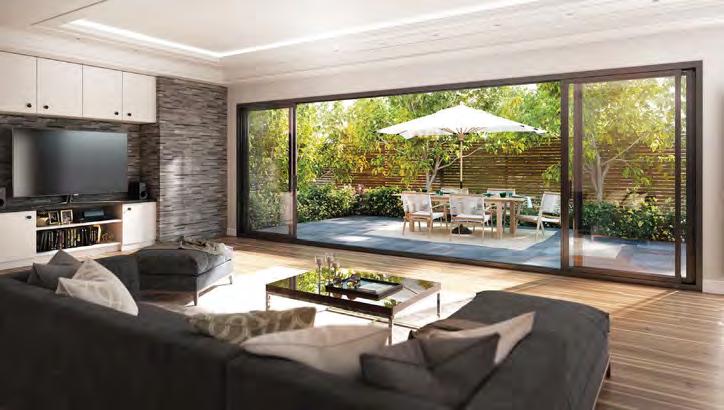




Stainless steel for a superior look and durability
Customizable in style and size
Created using 18 gauge stainless steel (including hardware) 80-A Linton Ave Stratford, ON N5A 0B1 Text: 519-274-9583 Phone: 519-271-0104 EHSSALES.CA
Indirect costs of the development application process can add $23,642 to $1.4 million to the price of a house, the study indicated, including annual property taxes paid on vacant land, cost escalation and opportunity cost of holding land vacant. On a monthly basis, indirect costs can add between $2,200 in Moncton and $10,000 in Toronto per unit in a low-rise development, and between $1,174 (Moncton) and $6,855 (Vancouver) per unit in a high-rise development.
“Overall, housing affordability, for both ownership and rental, has deteriorated to its worst level since the mid-1990s,” the study reports. “Rental vacancy rates are the lowest they have ever been in six of the 23 municipalities studied.”
To view the complete study, visit chba.ca/municipal-benchmarking.
The Carpenters’ Regional Council (CRC) has received nearly $27 million from Ontario’s Skills Development Fund (SDF) Training and Capital streams. This is an unprecedented investment in the province’s skilled trades workforce, which addresses the growing labour demands in the construction industry.

The SDF funding will expand existing CRC programs and launch new initiatives to train and upskill nearly 1,500 workers. Programs receiving funding include preapprenticeship training for highschool students and a Red Seal exam preparation course.
In addition, the investment will upgrade five union training centres across Ontario, enhancing their training capacity and expanding their curriculum for prospective and current tradespeople.
Ontario is expected to need more than 500,000 skilled trades workers over the next decade to meet the increasing demand for infrastructure and housing projects.

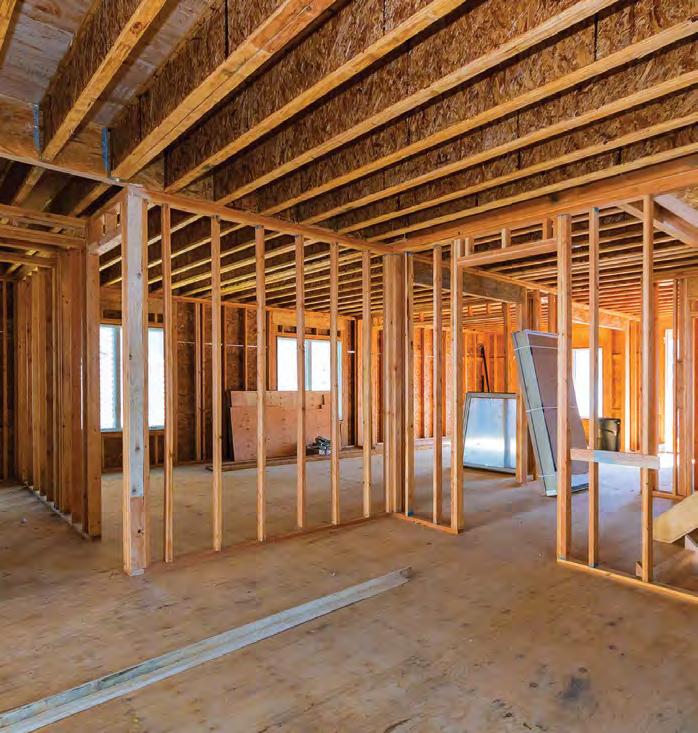
This marks a staggering increase from the estimated $900 million in 2018.
“These findings highlight an urgent need to streamline the site plan application process across Ontario to address the province’s housing crisis,” says Ted Wilson, president of the OAA’s governing council. “Meaningful policy changes are necessary to ensure municipalities adhere to timelines and build the housing supply Ontarians urgently need.”
The OAA will leverage these insights to inform discussions with government stakeholders, advocating for targeted reforms to expedite approvals, reduce costs and encourage timely housing development.
The Canadian Wood Council has released five new environmental product declarations (EPDs) for Canadian softwood lumber, oriented strand board (OSB), plywood, trusses and prefabricated wood I-joists. These EPDs provide comprehensive, transparent data on the potential impacts associated with the cradle-to-gate lifecycles of these essential wood products.
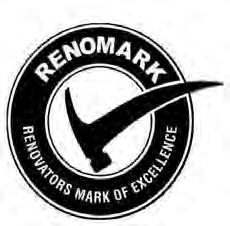
Developed as regionalized, industrywide business-to-business Type III declarations, the EPDs comply with the highest international standards, including ISO 21930, ISO 14025, ISO 14040, ISO 14044 and ASTM general program instructions for Type III EPDs. This ensures credible, third-party verified environmental impact data, supporting designers, builders and policymakers in making informed, sustainable material choices.
“The release of these new EPDs reinforces our commitment to transparency and sustainability in the wood products sector,” says Peter Moonen, National Sustainability Manager at the Canadian Wood Council. “By providing robust, sciencebased information, we’re equipping the industry with the tools needed to demonstrate the environmental benefits of wood and support lowcarbon construction.”
The EPDs are available for download from the Canadian Wood Council’s digital resource hub: cwc.ca. OHB

By Jonathan Oke
THIRTY YEARS AGO, standard toilets used 13 litres of water per flush. A string of innovations dropped that number to six litres, and now to as low as three, reducing a family of four’s daily toilet water use from 260 to as efficient as 60 litres.
However, few things will annoy and embarrass a homeowner more than a low-water model that doesn’t clean the entire bowl after flushing—and you aren’t saving any water if you have to flush twice.
Fortunately, most manufacturers are now designing for both efficiency and performance—from entry-level affordability to five-figure price tags. On the builder-grade end, U.S.
products remain popular among Ontario builders. Huron Creek Developments, for example, uses the American Standard Cadet as its go-to model. However, with the tariff situation, companies like Contrac are flexing their muscles.
Although manufactured in China by a top-tier producer, every Contrac product is developed in Canada specifically for our market. This helps ensure consistent quality and performance, which results in fewer callbacks from homeowner clients.
Headquartered in Mississauga and part of the Foremost Bath family, Contrac toilets meet the EPA WaterSense/Ontario Building Code
standard of 4.8L or less per flush and qualify for LEED Platinum certification. The company was also an early adopter of MaP (Maximum Performance) testing, a scientific method of measuring how many grams of waste a toilet can remove per flush. While 250g was once considered acceptable, today’s standard is 350g. Contrac’s models far exceed this, with flush capacities up to 1000g, and waste-pushing distances reaching 60 feet—20 feet beyond the industry benchmark. Even its 3L toilets are rated at 800g.
Contrac models reign at Brantford’s Marks Supply, which primarily deals with plumbers and contractors. “I’ve got three Contrac models in my own house,” notes Marks’ Jesse Stutsman.
So what’s new in potty progress?
“While the hardware inside most builder-grade toilets has remained generally similar in recent years— with standard flappers, Pro45 fill valves, etc.—the MaP rating has

improved. You don’t see anything under an 800 MaP rating anymore,” Stutsman says.
What has changed are the dimensions. Standard height (14.5”-16”) is going the way of the dinosaur in favour of comfort-height models (17”19”), Stutsman notes. Further, more ergonomically designed oval seats and bowls have overwhelmingly replaced round models, with the exception of constricted bathroom spaces.
Ronnie Grimshaw of Vaughan’s Plumbing Market echoes Stutsman in citing American Standard’s Cadet Champion and Contrac’s Carlin models as the heavy hitters in the buildergrade category—both costing around $350, including lined tanks.
Thus far, Grimshaw has not seen tariff updates on those two products, but here’s where it gets complicated: American Standard’s Cadet toilets are primarily manufactured in Mexico and China, so there may not be any tariff implications. And then there’s Toto. Although the company is Japanesefounded and owned, its Drake II twopiece model—possibly the best value in an affordable toilet (both with and
Whether a new build or renovation, homeowners are moving up to 'comfort height,' with skirted models preferred for easy cleaning. Image courtesy Kohler
without bidet seat options) and No. 1 on the New York Times Wirecutter ’s “Best Toilet Review” for seven years running—is subject to tariffs since it’s actually made in the U.S.
For builders seeking to avoid the confusion and ‘buy local,’ there’s Agua Canada, with three showrooms in Quebec and one in North York. Although manufactured in China, product design and R&D take place in Canada. Retailing for $399, Agua’s Tulum is a modern one-piece, dualflush design with an elongated, slowclose, removable seat. WaterSensecertified, it boasts a tornado-effect flush system (1,000g MaP) and a fully skirted trapway for easy cleaning.
Another internationally manufactured but Canadian-owned brand is 31-yearold Cleo. Touted as “affordable luxury,” its entry-level model is a one-piece, dualflush toilet starting at $299. Cleo’s smart toilets start at $756, with the higher-end Equinox ($1,399) being an integrated model with a bidet seat, auto-flush options, water temperature and pressure adjustment, Nano anti-bacterial technology, multiple wash options, UV sterilization and automatic deodorization.
When it comes to renovations, size matters, indicates Peter Di Scola of Salerno Construction Group.
“I’d say 80+% of our clients are opting for white comfort-height, elongated toilets. The remainder ask for a bit more—perhaps a shape that is easier to clean, or a one-piece or wall-hung model,” Di Scola says. “A few want the handles that match their plumbing fixtures, although that usually only occurs when a designer or good sales rep is also involved.”
Di Scola does not see many upgrades to bidet-style toilets. “I think the drawback is cost—and the fact that not too many people appreciate the features of that style. After all, it’s hard to test drive,” he laughs.
“One thing I have noticed is that there is very little brand awareness connected to toilets. It’s more a question of function or aesthetic.”
And what percentage of his clients are water-conservation-conscious when choosing a new model? “Not many,” Di Scola says. “There’s usually more concern about how well it flushes, how it looks and, of course, the price point.”
One piece of advice for renovators is to ensure that all your clients’ toilets are similar in height, especially if you have installed a new comfort-height model and there are older regular-height toilets in the house. Once you get used to a taller comfort-height product, it will feel like someone has pulled the seat out from underneath you whenever you go to sit on an old regular-height toilet. So if you’re changing over one, encourage the client to update them all.





Luxury Redefined The Toilet Paper Dilemma
Intimacy Begins with Confidence
Cleaner Choices for a Greener Future
Over 1 in 4
63% view bidet technology as a status symbol.
65% reveal they must use excessive amounts of toilet paper to feel clean.
56% say using a bidet would boost their confidence in intimate moments.

At Burlington’s Watermarks Kitchen & Bath Boutique, Kohler Reach is the biggest seller—a onepiece, comfort-height model that integrates the tank and bowl into a seamless, easy-to-clean design. Compact for an elongated toilet, and offering great value for a mid-range
model, it features a skirted design that hides the toilet trapway—something that’s becoming almost as common a request as comfort height, says Watermarks showroom consultant Suzanne Graham, who deals primarily with custom builders and their contractors.
are inspired to adopt bidet technology to reduce their environmental footprint, highlighting a growing shift toward sustainable living.
As Graham moves toward a Kohler smart toilet, another highlight is the remote controller. Its handsome design virtually blends into the countertop and offers options ranging from seat opening and heating to nightlights.
Her most expensive model—a statement piece that ventures into five-figure pricing (high four-figures for the building community)—is the Kohler Eir, with a rose gold accent band around the seat. This tankless model’s bevy of features includes a touchscreen remote and misting of the bowl prior to use for more effective rinsing.
While a bidet is a separate fixture typically installed near the toilet, modern bidet-seat models provide an all-in-one package with technology packed in, from custom cleansing to warm-air-drying capabilities.
While such models tend to be more of a custom-home inclusion, some builders are prepping in advance for some new builds. “We’re doing a ton of electrical rough-ins and warm water lines for purchasers of South Asian descent in order to provide bidet options in the future,”
Canadian owned manufacturers include Cleo (its high-end Equinox below) and Agua (its Tulum top right), with the award-winning Japanese-owned Toto Drake Washlet+ (bottom right).

says Mountainview Building Group Operations Manager Mike Memme.
It’s a trend closely observed by Toto, the world’s leading brand in electric toilet seats with bidet functions, with over 60 million Washlet bidet seats sold globally since the product’s debut in 1980. “We’re seeing builders adding warm water lines and GFCI outlets both here in the U.S. and Canada,” notes Toto USA Marketing Director Jarrett Oakley. “Washlet bidet seats have sustained double-digit growth in the Canadian market since 2020.”
Integrating a bidet washing function into the seat while adding an air-drying component reduces or even eliminates the need for toilet paper, and that’s good news for water conservationists, considering it takes 37 gallons of water to manufacture one roll of toilet paper.
But then Toto and its home country have long been at the vanguard of efficiency, Oakley notes. “In Japan, they even have toilet models where greywater from a bathroom sink atop the unit helps fill the tank to flush the toilet.”
While often considered a higherend brand, Toto’s innovative Tornado Flush technology and eco-friendly features are also available in their builder-grade models.
They’re also upgrading their popular C2 and C5 bidet seat models this summer. The new S2 and S5 Washlet bidet seats will be featured in tankless models, “meaning instantaneous warm water at your fingertips that will never go cold,” Oakley notes.
On the high end, the new Neorest NX2 (approximately $23,000 US), with its flowing lines, is appealing to architects, designers and designsavvy homeowners who are specifying smart-toilet technology for an elevated sense of personal cleaning and wellness, Oakley says. “Its finished porcelain design wraps all the way around, so it can be installed anywhere in a room. It doesn't have a wall side.”
While installing a bidet-seat model is more labour-intensive than a


standard toilet, it’s not that complicated, Oakley says. “We have a fastest-in-the-west installation contest at our trade shows, with people right off the floor watching a two-minute explainer video and then using just a Phillips-head screwdriver to successfully install a Washlet. The last winner took just one minute and 26 seconds. Of course, that’s not including the water lines or rough-in, but it shows how easy these are to install.”
And you get what you pay for, Oakley reminds. Unless something has gone wrong, “people in North America buy an average of two toilets in their lifetime,” he says. “Think of it along the lines of a mattress, which you spend one-third of your entire life on. You collectively spend over two years of your life going to the bathroom, so you want a product that provides a very high level of comfort, cleanliness and wellness. Customers want to invest in their personal hygiene today. So there’s a lot more to it than just going to your local store and picking up a $250 toilet. It’s a far different experience.” OHB







FOUNDED: 1951 MEMBERS: 436
OHB: So how did a Newfoundland boy end up as GOHBA’s Executive Director?
Jason Burggraaf: “I came to Ottawa to go to Carleton University and be close to Parliament Hill. I wanted to get into public policy and was exposed to non-profits and NGOs like OHBA. After graduating, I was hired by CHBA and spent 15 years there in a couple of different roles, including the last five as Government Relations Advisor. Then when John Herbert retired from this job in 2018, I was lucky enough to be chosen to take over. I’d interacted with (former OHBA Chair) Pierre Dufresne while I was at the national office, and he was the one I reached out to first when the opportunity arose.”
What was your vision coming in?
“I wanted to run the policy development and the advocacy side of things while building a team that could focus on member services and development. The idea was to have a structure where people operated relatively autonomously but whom I had confidence in to always do the right thing for our members. It’s a very different arrangement from when I started. Soula Burrell focuses on membership and business development. She also directs our outreach on LinkedIn—our primary social media voice to reach the local community and potential members. Tracey
Parslow runs our Trade Development Initiative and our Renovators’ Council. Amy Crooks supports me in our policy development while also taking care of our Builder Trade and Building Innovation Committees. Christina Pliatsika runs most of the admin side and our Housing Design Awards (HDAs), which last year saw 800 people attend our awards gala.”
How is this paying off in terms of numbers?
“Membership is up to 436—a 33% increase over the past two years. It’s kind of like a gym membership—you can sign up, but if you don’t put in the time and work, you won’t get much value out of it. So we put a big focus on understanding what members want and communicating to help them get the value out of the association that they’re looking for.”
What makes GOHBA unique?
“The Ottawa market feels like a small town in that we are isolated from other big municipalities. Most of our builders are homegrown. At the same time, we’ve found good value in investing time and effort at the provincial level to offer an Ottawa context on housing policy that’s often different from that of the GTA.
“We’ve also had great success with HOWL (Home Builders of Ottawa Women Leaders), which looks at the changing dynamics of the workforce

EXECUTIVE DIRECTOR
and is committed to fostering a more equitable environment.
“We also have one of the bigger contingents of renovators in Ontario, so we really strive to ensure that we’re representing them well. And they’ve won a lot of awards!”
What challenges occupy most of your
“It’s definitely the issues on the ground with City Hall—the application process, development charges, zoning and land availability. The current growth projection for Ottawa is 50% larger than what’s in our Official Plan, so in all these aspects we want to ensure that there’ll be a sufficient amount of housing to accommodate our growing population.”
“I’d say the overall success of our events, for which we’ve seen fantastic response. On top of our HDAs, we had a very successful Eastern Ontario Housing Summit last May that saw more than 300 attendees and 35 municipalities represented. We’re also proud of our annual RenoTour. Like a parade of homes, we’ll have 10 to 12 renovation projects that the public can visit and talk to the renovator members who did the work. Finally, our recent Breakfast with the Mayor event drew over 180 attendees. I think our events reflect a real buzz about what GOHBA is doing.” OHB























































All-Indoor Design
in

Designed for seamless thru-wall installation, the Napoleon Condo Pack delivers powerful heating and cooling with a sleek, all-indoor design—keeping exteriors clean and modern. Ideal for residential high-rises, institutional, and industrial applications, it eliminates exterior equipment and refrigerant connections, offering enhanced protection against extreme weather and damage. With a pre-wired, pre-charged dual sliding chassis, installation and maintenance are effortless. Plus, our industry-leading quality control ensures long-lasting, worry-free performance. Efficiency, durability, and aesthetics—all in one unit!
